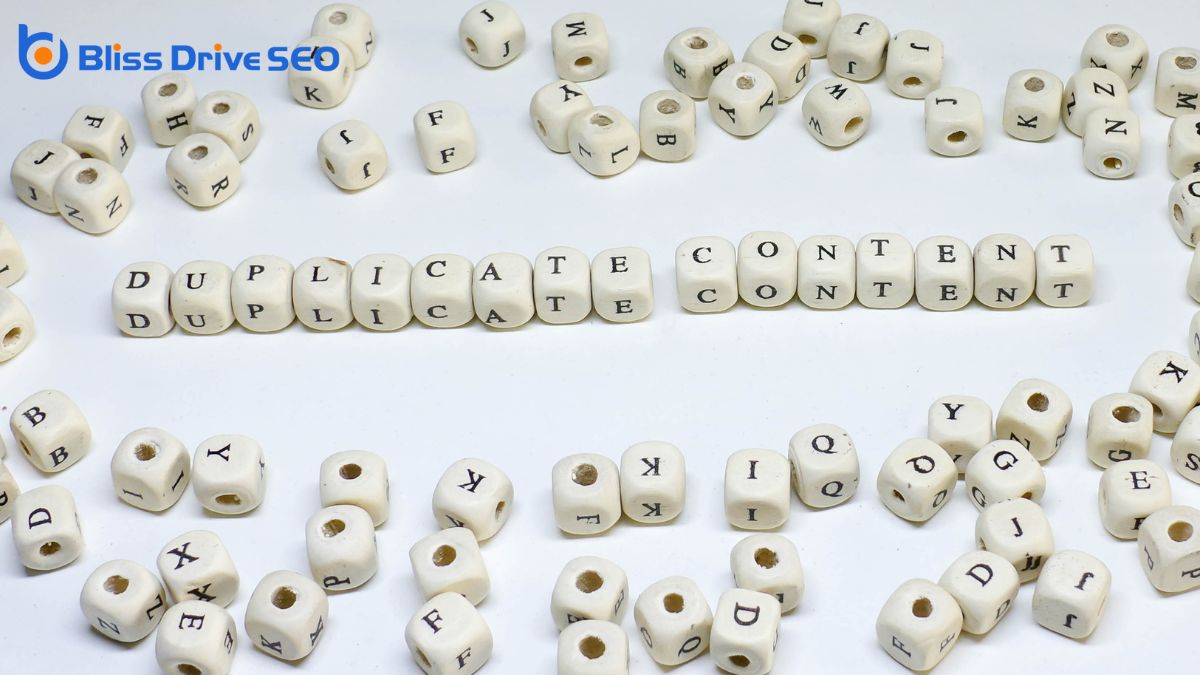Digital Marketing Services
Learn More About Us

Canonical tags help you handle duplicate contentContent that appears on more than one web page, which can negatively impact SEO. by telling search engines which version of a webpage you prefer. Place these tags in the HTML head section to point to the original URL, ensuring search engines prioritize the right page. This practice maintains your site's SEO value and authority by preventing confusion from duplicate pages. Use self-referential canonical tags for original content to optimize visibility and avoid issues. Proper placement, clear signals, and absolute URLs are key to successful implementation. Continue on to discover more about mastering canonical tags and managing your content effectively.
Canonical tags are vital tools for managing duplicate content on your website. They specify the preferred version of a webpage, helping you address duplicate content issues effectively. When you use canonical tags, you're essentially informing search engines which version of the page should be considered the primary one. This is pivotal for maintaining the SEO value of your original content.
Search engines use canonical tags to identify the primary version of a page for indexingThe process of adding web pages into a search engine's database., ensuring that duplicate pages don't diminish your site's authority. By indicating a canonical URLA URL that is considered the master copy, helping to avoid duplicate content issues., you prevent duplicate content issues that could impact your search rankingsThe position at which a website appears in the SERP..
Self-referencing canonical tags, where a page points to itself as the canonical version, are a best practice for canonical management to avoid any confusion.
Implementing canonical tags correctly directs search engines to the correct URL, safeguarding your content's visibility and authority. This approach not only prevents ranking issues but also enhances your overall SEO efforts. Understanding the role and significance of canonical tags is vital for anyone looking to optimize their website and maintain a strong online presence.

To create a canonical tag, start by placing it in the HTML head section of your webpage.
You'll need to input the preferred URL you want search engines to prioritize.
Follow specific implementation steps to guarantee it's correctly set up and effectively manages duplicate content issues.
In the field of SEO, placing canonical tags correctly is vital for managing duplicate content effectively. You need to position the canonical tag within the HTML head section of your webpage. This is done by adding a '' element with the attribute 'rel="canonical"' and specifying the preferred URL. Proper placement of this tag is essential because it directs search engines to the desired version of your page, helping you avoid indexing issues.
When you're implementing canonical tags, make sure each page's tag is unique and points to the original URL. This helps search engines understand which version of the page you want to prioritize, thereby managing duplicate content more efficiently.
When it comes to specifying your preferred URL, it's crucial to understand how to create an effective canonical tag. To do this, you need to input the URL of your preferred page into the Canonical URL section of SiteFarm under Additional Options > SEO. This step is essential for managing SEO, as it directs search engines to prioritize the preferred content over any duplicated versions.
By implementing a canonical tag, you're ensuring that search engines recognize which page should be visible in search results, thereby controlling the visibility of duplicate content. Without the correct canonical tag, search engines might choose the wrong version of your content, leading to lower rankings and reduced visibility.
Make sure that the canonical tag accurately specifies the preferred page. This helps protect your content from being hidden in search results due to duplication issues.
Correctly implemented canonical tags are crucial for maintaining the integrity of your SEO strategy, ensuring that the preferred page is always highlighted and prioritized in search engine results. So, take the time to input the preferred URL carefully to safeguard and enhance your website's visibility.
Creating a canonical tag involves a few straightforward steps that can greatly enhance your website's SEO.
First, access the SEO settings in SiteFarm and locate the Canonical URL section. Here, you'll input the URL of the preferred version of a page. This directs search engines to recognize this URL as the canonical version, helping you avoid duplicate content issues.
Using canonical tags correctly guarantees that search engines know which page to prioritize for indexing. This is important to prevent mixed signals that can arise from duplicate content appearing in multiple places. Properly implemented, canonical tags direct link authority to the canonical version, enhancing its search ranking.
For self-referencing canonical tags, simply enter the URL of the current page into the Canonical URL section. This clarifies to search engines that the page is its own canonical version, further preventing duplicate content issues.
You should use canonical tags whenever you identify duplicate content across multiple URLs. They're essential for specifying which version of a page search engines should prioritize.
Duplicate content can, indeed, be an important issue for websites, often leading to search engine penalties if not addressed properly. Identifying duplicate content is the first step in effectively using canonical tags.
When you have identical content or very similar content across multiple URLs, search engines might struggle to determine which version to display in search results. This is where canonical tags come in handy.
By implementing canonical tags, you can signal to search engines which version of the content is the preferred version. This is vital for avoiding duplicate content penalties. These tags are especially useful for managing content syndicationRepublishing content on third-party sites to reach a broader audience. across different websites.
When the same article or blog post is published on multiple sites, canonical tags help guarantee the original content creator receives proper attribution and visibility.
For example, if you're the original content creator, adding a canonical tag to syndicated content ensures that search engines recognize your version as the authoritative one. This way, you avoid duplicate penalties and maintain your site's ranking.
Effective use of canonical tags is important in maintaining a clean, efficient website that search engines can easily navigate and understand.
Implementing canonical tags is a vital step in managing your website's SEO health, especially when dealing with duplicate content. By using canonical tags, you tell search engines which version of a page is the preferred one. This helps prevent SEO issues such as ranking problems caused by duplicate content appearing in search results.
When you have multiple pages with similar or identical content, place a canonical tag on the duplicate pages. This tag should point to the original URL or the preferred version of your content. Doing this directs search engines to index the correct page, ensuring your content is properly recognized and ranked.
Canonical tags are essential for managing content duplication. They help maintain your website's SEO integrity by preventing search engines from getting confused about which page to display.
Proper implementation of these tags means that you avoid potential ranking problems and have better control over the visibility of your duplicate content.
When managing original content, using self-referential canonical tags is vital for optimizing search engine visibility. By employing self-referencing canonical tags, you can specify your page's URL, guaranteeing search engines prioritize your original content over duplicate content. This not only aids in proper attribution but also enhances the visibility of your content in search results.
Search engines depend on canonical tags to comprehend which version of a page should be indexed and ranked. When you utilize self-referential canonical tags for your original content, you're informing search engines that this specific page is the authoritative source. This can greatly improve your content's authority and credibility, leading to better search rankings.
It's important to be clear and precise with your canonical tags to avoid mixed signals that might confuse search engines. This precision ensures that your original content receives the recognition it deserves, preventing other versions from diluting your search engine authority.
Essentially, self-referential canonical tags are a foundational tool for anyone serious about maintaining the prominence and integrity of their original content online. So, always make sure your original content is properly tagged to maximize its impact.

Ensuring clarity in your canonical tags is vital to avoid mixed signals that could confuse search engines. A well-implemented canonical tag tells search engines which version of a page should be prioritized, helping you avoid mixed signals and prevent confusion.
To start, avoid chaining canonical tags. This means you shouldn't point one canonical tag to another canonical tag. Instead, link directly to the original content creator to maintain consistency.
If you've got duplicate content published elsewhere, request those publishers to include canonical tags pointing back to your original content.
It's essential not to canonicalize incorrect versions or 404 pages. Doing so can leadA potential customer referred by an affiliate who has shown interest in the product or service but h... to search engine misinterpretation, causing your intended content to lose visibility.
Always use self-referential canonical tags on your original content. This practice ensures search engines understand which version is the correct one, avoiding mixed signals.
Although canonical tags might seem straightforward, following best practices can greatly enhance your site's SEO performance. To start, always use absolute URLs in your canonical tags to guarantee clear and accurate redirection for search engines. This approach helps avoid duplication and makes your intentions crystal clear.
Next, implement only one canonical URL per page. Multiple canonical URLs can confuse search engines, leading to poor indexing and ranking. Remember to place these tags in the head section or HTTP header of your webpage for proper indexing.
It's also essential to use canonical URLs only for indexable pages. Including them in XML sitemaps or non-indexable pages can mislead search engines, hindering your SEO efforts. For pages with similar content, a canonical tag tells search engines which version you prefer to be indexed, helping you manage duplicate content effectively.
Avoid chaining canonical tags or mixing them with 301 redirects. Such practices can create a tangled web of signals, confusing search engines and diluting the effectiveness of your SEO strategy. By following these best practices, you can guarantee that your canonical tags serve their purpose efficiently, boosting your site's visibility and search engine ranking.
A canonical tag example is ''. You use it in the HTML code to tell search engines which page to prioritize, helping you avoid duplicate content issues and improve SEO.
You use the "rel=canonical" tag to stop duplicate content. By placing it in your HTML head section, you direct search engines to the preferred version of a page, maintaining your content's authority and improving your SEO.
A canonical element tag, or rel=canonical, tells search engines which webpage is the preferred version among duplicates. It helps avoid ranking issues by ensuring the right page appears in search results, boosting your SEO efforts.
You should use a canonical tag when you have duplicate content across different URLs, including pages with parameters or tracking codes. This helps search engines know which version to index and rank, preventing duplicate content issues.
In short, canonical tags are your best friend when it comes to managing duplicate content. By understanding how to create and use them, you guarantee that search engines know which version of your content is the original. Avoid mixed signals and follow best practices to boost your SEO efforts. Remember, keeping your content strategyA plan for creating, publishing, and managing content to meet business goals. clean and efficient will ultimately help your site rank better and attract more visitors. So, don't overlook the power of canonical tags!
